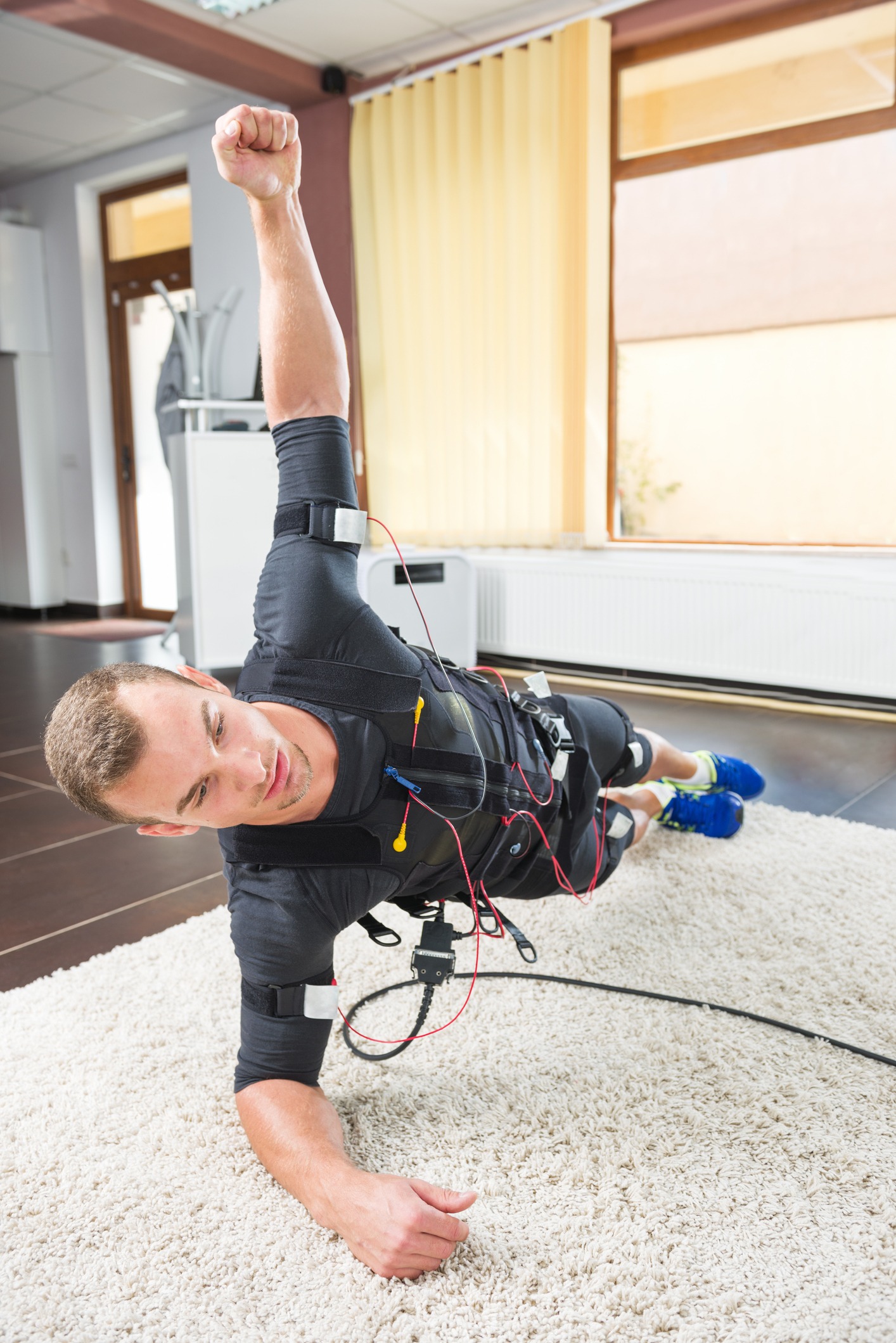
What’s the Hype about EMS?
When I first saw a trainer wandering around the gym with an EMS cart plugging clients in with electrodes, I thought “What now?”. Is this just another gimmick claiming to be a quick and easy way for muscle gain, without doing the work? Another shortcut promising a muscular and ripped physique?
I compared it to other shortcuts like the “Toning Tables” and vibration platforms of the past that all claimed an increase in results with no effort. All you had to do was strap yourself to a table and let the machine move for you or stand on that vibration platform and let the machine jiggle you to fitness. I could keep going with this and the Shake Weight, but I think you get the sentiment.
So, what is EMS?
Electrical Muscle Stimulation (EMS) is a technique that uses electrical impulses to stimulate muscle contractions. So instead of you actively contracting the muscle, the electrical impulses cause more of an involuntary contraction. Changing the frequency of the electrical impulse modifies the strength and intensity of the contraction. EMS has various applications, including rehabilitation, pain relief, athletic performance enhancement, and muscle development.
What’s the difference in EMS and TENS?
One common misconception is that EMS and Transcutaneous Electrical Nerve Stimulation (TENS) are the same, but they serve different purposes.
TENS is primarily used for pain management. It involves the application of low-frequency electrical pulses to the skin, targeting the sensory nerves. The theory behind TENS is based on the gate control theory of pain. The electrical stimulation activates the sensory nerves, effectively closing the “pain gate” in the spinal cord and reducing the perception of pain. TENS can be beneficial for conditions like chronic pain, arthritis, and musculoskeletal injuries.
On the other hand, EMS focuses on stimulating muscle contractions directly. It uses higher-frequency electrical pulses that target the motor nerves, causing the muscles to contract. EMS is often utilized in the context of athletic performance to complement strength training and promote muscle gains.
Furthering the confusion is that EMS, muscle stim, is a common chiropractic therapy used as a treatment modality for people experiencing pain and spasm. In this context, mild electric current is applied to the muscle to cause fast repetitive contractions to the muscle. The fast contractions to the muscle help to fatigue the muscle (as a workout would), allowing it to relax settling the spasm. Stimulating these fast contractions also prompts the body to release endorphins which are the body’s natural pain killers.
Common EMS devices
In terms of EMS for athletic performance, there are different types of EMS devices. Some athletes use full body suits equipped with electrodes, which can simultaneously stimulate multiple muscle groups. These suits are often used for recovery purposes, as well as enhancing muscle activation during training.
Additionally, there are electrode cart units used in gyms and sports facilities that allow individuals to target specific muscle groups or areas during their workouts and sports training, intensifying the muscle activation. These electrode units are used on individual muscle groups while the person is also performing an exercise targeting that muscle. A lighter weight is used which would normally only supply a minimal contraction and muscle fiber recruitment. However, with the high-frequency electrical pulse applied to the muscle, the trainee will experience a much more intense contraction mimicking using a much heavier resistance and effort.
Are there safety issues?
There will always be safety issues with any device. It is not generally the device, but the person misusing it. Always follow the manufacturer’s directions and guidelines.
The FDA regulates individual devices, but not the full body electrode suits. Use of these suits is considered the “practice of medicine.” No one is keeping tabs on the strength of currents being used for treatments.
Nicola Maffiuletti, a rehab specialist at the Schulthess Clinic in Zurich, said “Moderate muscle damage can be positive for strengthening muscles”, but with do-it-yourself EMS “there can be very heavy muscle damage.” Maffiuletti described in an editorial article published in 2016 a 20-year-old man who spent 5 days in a hospital after a fitness professional put him through a session in a full body EMS suit. The young man suffered from rhabdomyolysis, or an extreme breakdown of muscle tissue.
Since there isn’t much regulation on these devices, things can go wrong very quickly.
Too little current produces no effect. Too strong of a current can destroy muscle cells. Maffiuletti compared it to a person running for 10 hours straight with no endurance training. He said “It doesn’t make any sense. It is oriented to healthy people for treatment, but for healthy people we know normal exercise is much more effective than whole body electrical stimulation.”
What does research say?
Published research suggests that EMS can be an effective complement to traditional strength training for muscle development. EMS has been shown to increase strength and power output, which correlates with possible increases in muscle size. However, it’s important to note that EMS should not be considered a replacement for conventional lifting exercises but rather as a supplementary tool.
EMS can also be used for developing explosive power and enhancing athletic performance. By targeting fast-twitch muscle fibers, EMS can improve muscle recruitment and coordination, leading to increased power output during explosive movements like jumps or sprints.
Regarding weight loss and body fat reduction, research has not shown EMS as being reliable for achieving these goals. A combination of resistance training, aerobic activity, proper nutrition, and a balanced lifestyle is essential for sustainable weight management.
How long does it take to see benefits?
The time it takes to see benefits from EMS varies depending on the individual and the specific goals. Some people may notice improvements in muscle strength and endurance after a few weeks of consistent EMS use. However, it’s important to follow a structured training program and use EMS in conjunction with appropriate rest and recovery periods.
For any other claims such as: weight reduction, girth reduction, cellulite removal, body shaping and contouring and spot reducing the FDA (2013) states that EMS machines are misbranded.
How long it takes to see results, and if you will see results is still debatable. One study by Porcari (2002) conducted with college age volunteers found that EMS performed 3 times per week had no effect on body composition, physical appearance, or muscular strength.
Unicorns and Anomalies
Claiming and determining “results’ involves many variables. For instance, a client asked me what I thought about EMS. Her friend, who ran and worked out in the gym regularly, started EMS treatments twice weekly. She quit the gym in lieu of the EMS treatments. Within a short period of time, the friend looked lean and muscular, in better shape than she had ever been. I was asked why this happened if EMS doesn’t work.
I don’t have an answer for everything; however, logically it tells me that when she worked out in the gym, she did very little as far as heavy weights or intensity. Those 2x week EMS sessions were much more intense than anything she ever did on her own. I have no knowledge of her dietary habits, so can’t comment on whether she made adjustments. All I can say is research doesn’t really back up EMS use for weight loss.
Often people will bring up one person, a unicorn, who has a result outside the norm. I often hear “I have a friend that eats anything she wants, and only does yoga, and she’s muscular and ripped.” Well, she’s a lucky girl…but it’s not the norm.
Who, What, and Why?
Another thought comes to mind as I deep dive inside my head questioning the who, what, and why variables surrounding EMS. Who can benefit? What determines results? And why do results seemingly vary to such a great extent?
I think benefits may come greatly to the person who doesn’t yet possess the ability to muster up precision, great effort, and force in their training sessions on their own. Let’s face it, most people in the gym sling weights around but engage very little muscle tissue. Some of this is an inherent lack of body awareness and coordination that honestly may never come. Zapping the muscle with a current that simulates possessing the ability to give maximum effort will likely create a positive outcome.
If you are already at the point that you are spending a great amount of time under maximum beneficial tension, yet you have reached a plateau, properly programmed EMS sessions may help push through that sticking point. This is the case with elite athletes and bodybuilders.
Results with EMS vary greatly because people are all over the spectrum when it comes to their current level of conditioning and their genetics for muscle building and strength.
The third influential factor involves the psychology of sport and training. The mental makeup of a participant is as important as the physical. One’s perception of pain and discomfort and the ability to tolerate to a great degree is a trait that matters when participating in any intense physical endeavor. It is the difference between an elite athlete and just a recreational exerciser. It is often what determines success and failure.
No one gives 100% all the time. Some people give 20% and believe they are giving the maximum. Elite athletes give 90% and believe they could do so much more.
A former client would always ask me about reaching his full potential and get bummed out if he thought there was something out of his control that kept him from this “full potential.” This could be starting too late in life, or not being able to sleep at night. Then there were the controllable things like being consistent, putting forth your best effort each workout regardless, and not making excuses for yourself. I explained that absolutely NO ONE reaches their full potential because no one on the planet gives out 100% all the time and does so for the entirety of their lives.
So, this being said, if EMS can help people push through their weaknesses and lack of mental capacity for intensity, it will help them bump up to another level. It may be a very small step, but anything is usually welcomed and motivational.
I do believe that use of EMS must be limited and very carefully programmed to maintain results and remain a safe complement to standard training.
Is EMS safer than traditional training?
Advertisements for EMS devices claim that it is safer and more effective to train when adding EMS to your workouts. There could be some validity regarding the claim that EMS is safer because it allows for lighter weights while providing the same muscle contractions as heavier loads. By reducing the external load on joints, ligaments, and tendons, EMS can potentially lower the risk of joint-related injuries as you are executing an EMS assisted lift.
However, it’s crucial to consider the strength balance between muscles, tendons, and ligaments. Very little research has been done on this dynamic when it involves EMS use. I question If muscle strength or power develops significantly faster than tendon and ligament strength, can EMS increase the risk of injury during explosive movements when not connected to an EMS device? Remember, EMS is generally used during workouts while using a reduced resistance, but at the same time generating a greater contraction than would normally be possible for the workload.
Unless you are going to use an EMS device on every workout or sports training session, utilizing reduced workloads, I believe this might be an issue. Some of the research shows a marked increase in power output improving movements like vertical jumps, sprints, and other ballistic movements. These movements take a very progressive training protocol. Tendons and ligaments generally take more active training time to match increases in muscle strength. What happens when muscle strength is considerably greater than the surrounding tendons and ligaments? From my experience, traumatic tears, and joint injuries.
Therefore, in my opinion, it’s important to use EMS minimally. In the long run, normal heavy progressive strength training and loading, allowing ample time for the tendons and ligaments to adapt and strengthen, offers the safest alternative.
Proceed cautiously
Of course, I may just be a bit bias in my viewpoint. After over 40 years in bodybuilding and fitness, I’ve watched so many things come and go that claim to give you an advantage without doing the work. I’m not a fan of other things of this nature either, like occlusion training. All these things are designed to trick the brain and body into thinking you are doing a difficult workout when you are not.
These training aids often end up having unintended consequences. Years ago, when the vibration platforms were sprouting up everywhere, a client of mine decided to use one while on vacation in France. The intense vibration ended up sending her to the hospital while out of the country due to it dislodging kidney stones.
I’m an old school guru. Learn perfect form and learn to train with intensity. There are no shortcuts.
EMS has its place. It is great for individuals who are disabled or would otherwise suffer severe muscle atrophy due to disease or the inability to move or exercise. Otherwise, it should be looked at cautiously.
In conclusion, EMS has various uses, including rehabilitation, pain relief, and athletic performance enhancement. TENS is primarily used for pain management, while EMS directly stimulates muscle contractions. EMS can be beneficial for muscle development, power generation, and enhancing athletic performance when used in conjunction with traditional strength training. However, it’s crucial to recognize the importance of balanced strength development to avoid potential imbalances and injuries. As with any training modality, consulting with a qualified professional and following a well-designed program is essential for safe and effective use of EMS.
References:
https://www.ncbi.nlm.nih.gov/pmc/articles/PMC6104107/
https://academic.oup.com/ptj/article/82/10/1019/2857684
https://www.aipt.edu.au/articles/does-electric-muscle-stimulation-work
https://sites.udel.edu/coe-engex/2017/05/08/electric-muscle-stimulation-an-athletic-advantage/
https://www.sciencedirect.com/topics/medicine-and-dentistry/electrical-muscle-stimulation
https://www.statnews.com/2016/04/07/fitness-electrical-muscle-stimulation/
https://journals.physiology.org/doi/full/10.1152/physiol.00015.2019
https://paulogentil.com/pdf/The%20Effects%20of%20Electrical%20Muscle%20Stimulation%20%28EMS%29%20towards%20Male%20Skeletal%20Muscle%20Mass.pdfhttps://www.healthline.com/health/pain-relief/e-stim#takeaway
https://www.mdpi.com/2076-3425/11/3/339
https://legionathletics.com/does-electrical-muscle-stimulation-work-what-the-science-actually-says/
https://www.shape.com/fitness/trends/electrical-stimulation-workouts
https://www.medicalnewstoday.com/articles/electrical-muscle-stimulation#pain-management
https://www.popsci.com/ems-electro-muscle-stimulation-workout-science/
https://www.bbc.com/news/business-62887379
https://www.quickanddirtytips.com/articles/how-to-get-fit-using-electrical-muscle-stimulation-ems/
https://www.scientificamerican.com/article/how-to-get-fit-using-electrical-muscle-stimulation-ems/
https://www.webmd.com/pain-management/what-to-know-about-electrical-myostimulation




